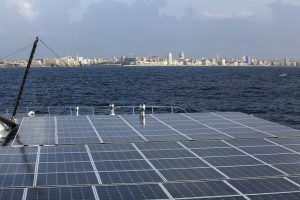Bvlgari is proud to announce its contribution to the Race for Water initiative
in order to help preserving water, the most precious resource of the planet
Since the beginning of August, scientific teams from the NGI (Norges Geotekniske Institutt) and the CEAC (Centro de Estudios Ambientales de Cienfuegos) have used Race for Water to collect microplastics samples along the Havana coast. This campaign is part of the Weather-MIC project, sponsored by the pan-European JPI Oceans project, and directed by Dr. Hans Peter Heinrich Arp. During his final days on board Race for Water, Dr. Arp gave us some additional details on this project, which is a major contributor to the fight against plastics pollution.
Can you put your microplastics weathering study into context for us? Why is it important to understand microplastics weathering in order to fight plastics pollution?
Dr. Hans Peter Heinrich Arp: “We need to know more about plastic and microplastic weathering in the ocean for two main reasons. First, much of the plastic that ends up in the oceans is unaccounted for, we don’t know where it is or where it goes, and understanding weathering may help us to find it. One hypothesis is that weathering changes plastics into very small microplastics—nanoplastics–which are hard to see and quantify. Another hypothesis is that weathering causes plastics to sink, for example by being covered in plant or animal materials. There may be some underwater “garbage patches” that we have not found yet. The only way to answer this question is through better understanding of weathering. Secondly, if we continue to consume and dispose of plastics at a much greater rate than they can be weathered and degraded by natural processes, we will continue to see plastic accumulation, and possibly see more plastic than fish in the oceans by 2050 (according to one estimate). We need to know how this plastic weathers, in order to understand what future risks this entails, such as how much plastic will enter marine life and end up in our seafood, and if weathering increases or decreases the harm to marine life.”
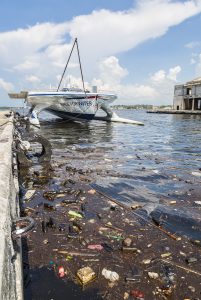
What kind of experiments you did you perform in Cuba? And why Cuba?
Dr. Hans Peter Heinrich Arp: “We are collecting primarily three kinds of samples: 1) manta-net surface water samples, which collect floating materials, 2) water samples at different depths and 3) sediments. We will attempt to quantify the microplastics in each of these three types of samples at different stations along the coast line of Havana (from East of the Bay of Havana to the outflow of the Rio Alamanderes) and up to 10 nautical miles into the sea. This will give us a good overview of the distribution of microplastics from Havana into the ocean.
Cuba is a very interesting area for this research because there is hardly any microplastic data, compared to areas around Cuba such as the Sargasso Sea. It represents a “blank spot” geographically, in terms of what we know about worldwide microplastic distribution. Cuba is also interesting as it likely has different plastic consumption patterns than surrounding nations.
Another interesting reason is that microplastic research is very new to Cuba and the Cuban population. So it is very exciting to be amongst the first researchers conducting a microplastic sampling campaign on this scale here.”
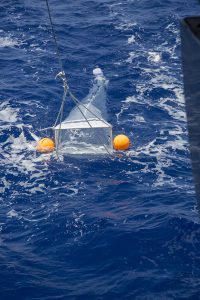
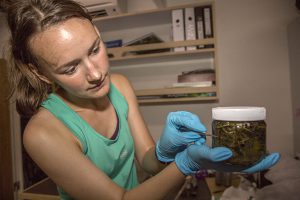
How will the collected samples will be analyzed? By different European laboratories? What are the expected results?
Dr. Hans Peter Heinrich Arp: “The first step is sample processing, which will be done at both NGI and CEAC. The main goal of this is to separate and quantify the microplastics we see in each sample. NGI and CEAC will compare results. Afterwards, the more interesting samples will be sent to colleagues from the JPI Oceans Weather-MIC network, to look for signs of weathering, based on the “weathering fingerprints” we are developing. The data will then be interpreted to get an idea of the distribution and weathering behavior of microplastics off the coastline of Havana and outward.
Our preliminary results so far indicate that we expect the Rio Alamandares is the main source of emission, and that microplastic concentrations outward in the Sargasso sea current may be more plentiful than near the coast of Havana, but this will require more analysis before confirmation.”
Who goes with you, when you do this sampling?
Dr. Hans Peter Heinrich Arp: “From the NGI, I am accompanied by my colleague Linn Merethe Brekke Olsen, who has been working with me on microplastic research for over a year. In addition, a new Masters student, Øyvind Lilleeng is also joining us. This trip represents the start of his project, which he will analyze as part of his Master’s thesis.
In Cuba we are collaborating with Prof. Carlos Alonso and other energetic marine researchers from CEAC (Centro de Estudios Ambientales de Cienfuegos). Carlos did an enormous amount of work to arrange all the necessary permissions for this sampling event.”
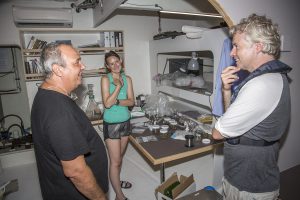
How is collaboration with the Cuban scientists going? Could you tell us more on the division of roles? How do they help you? Do you have common interests?
Dr. Hans Peter Heinrich Arp: “The collaboration with the Cuban researchers has been excellent. With their knowledge of the area, we were able to design a very interesting sampling campaign. We are dividing up most of our samples so that they will be analyzed at both CEAC and NGI, so that we can share data and results. In addition, we are also informing them of our methods for quantifying microplastics, so there is a great level of cooperation and knowledge-sharing. We plan on combining all of our data in a joint publication.”
And how is it going with the crew?
Dr. Hans Peter Heinrich Arp: “The Race for Water crew has been absolutely fabulous. They are extremely flexible and capable, doing their utmost to help us get our samples. They are essentially doing all the work for the Manta Net sampling, and are doing a fantastic job of it. The entire crew is in great spirits, with lots of joking around and delicious food.”
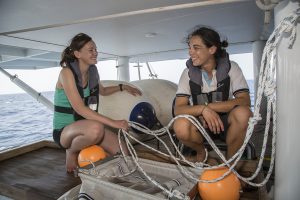
What interests you the most, in terms of what Race for Water has to offer?
Dr. Hans Peter Heinrich Arp: “To me, the Race for Water platform represents the future, and what I think the future should look like. It is an environmentally-friendly vessel that travelled to Cuba with almost no carbon emissions; in fact a much smaller environmental impact than my own flight to Cuba! On its journey, Race for Water is doing important scientific and outreach work to alert the planet about microplastic sampling, and promoting research and solutions. The Race for Water platform is state of the art, but in the future I would like to see more boats like this vessel, and more international cooperation to solve the problem of global microplastic pollution. I am thrilled and honored to be a part of it, and also thrilled to be collaborating with the Race for Water Odyssey, Weather-MIC and NGI.”
